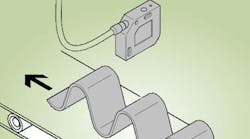Due to recent advances in micro-sensing technology, tasks that once seemed relatively complex can now be addressed with the use of inexpensive sensors. These devices perform sensing duties, plus include a fairly high degree of intelligence to execute a degree of decision-making. Such capabilities leave critical calculations and controls to the centrally located intelligent device while relieving it of unnecessary duties.
For contouring applications, three primary sensing technologies exist: Optical sensing, inductive sensing, and actuator feedback.
Optical sensing
Just as a light sensor uses position-sensitive detectors, optical sensors transmit light to an object, evaluate the diffuse reflection detected by the sensor, and then calculate the distance. At the analog output, there is a signal proportional to the distance between the object and sensor. Such sensors are typically suitable for applications in which the sensor does not need to be distant from the object or surface being sensed, in fairly clean environments, and where high accuracy is required. Also, the light path between the sensor and the object or surface being sensed should be relatively free of smoke or dust particles and should be sufficiently well lit — or sensing accuracy is compromised.
Consider a distance-sensing application in which the objective is to sense the distance between the sensor and a contoured workpiece. The taught-in contour coordinates already reside in the central PLC and distance measurements are taken on each new workpiece to meet quality specifications. At points where crests are detected, a metal saw precisely trims the contoured workpiece.
Once the sensor position is fixed and crest points are taught into the sensor, detecting the crests becomes a repetitive task. Such sensing techniques deliver a high degree of accuracy, with displacement resolution of 0.001 mm common today.
Inductive sensing
Basic inductive sensors are also non-contact, but respond to metal or galvanic objects. The sensor itself consists of a coil carrying an alternating current to generate a magnetic field. When the approaching object or surface is within the sensor’s magnetic field, the sensor produces an analog output proportional to the object’s distance from the sensor.
Imagine an application in which an analog inductive sensor is used to detect the slanting edges of a plate for which some kind of molding is to be implemented. Depending on the feedback provided, the central PLC directs the electric drive to position the slide and allow the molding mechanism to do its job. An inductive sensor also can be used to sense the distance of a non-linear surface and help position the surface below it accordingly.
Inductive sensors are relatively inexpensive and can be used in difficult environments where ambient elements are too harsh for delicate optical sensors — well suited where low accuracy and high robustness are required.
Actuator feedback
When using actuator feedback sensors, the sensing is either contact or non-contact. The sensor is mounted on an actuator that usually comes in contact with the workpiece to be sensed. The sensor provides an analog output proportional to the actuator’s stroke. Typical applications for this type of sensing include clamping, quality inspection, wear monitoring, and process monitoring.
In inspection applications, the length or thickness of the components can be confirmed using an actuator feedback sensor. Then those with unacceptable geometry are sorted into a reject bin. Similarly, in grinding and polishing applications, actuator feedback sensors can be used to monitor a grinding disc’s feed motion. Actuator feedback sensors are very robust, and several manufacturers supply these devices as actuator/sensor kits to simplify setup.
For more information, call (631) 404-3228 or contact the author at [email protected].
